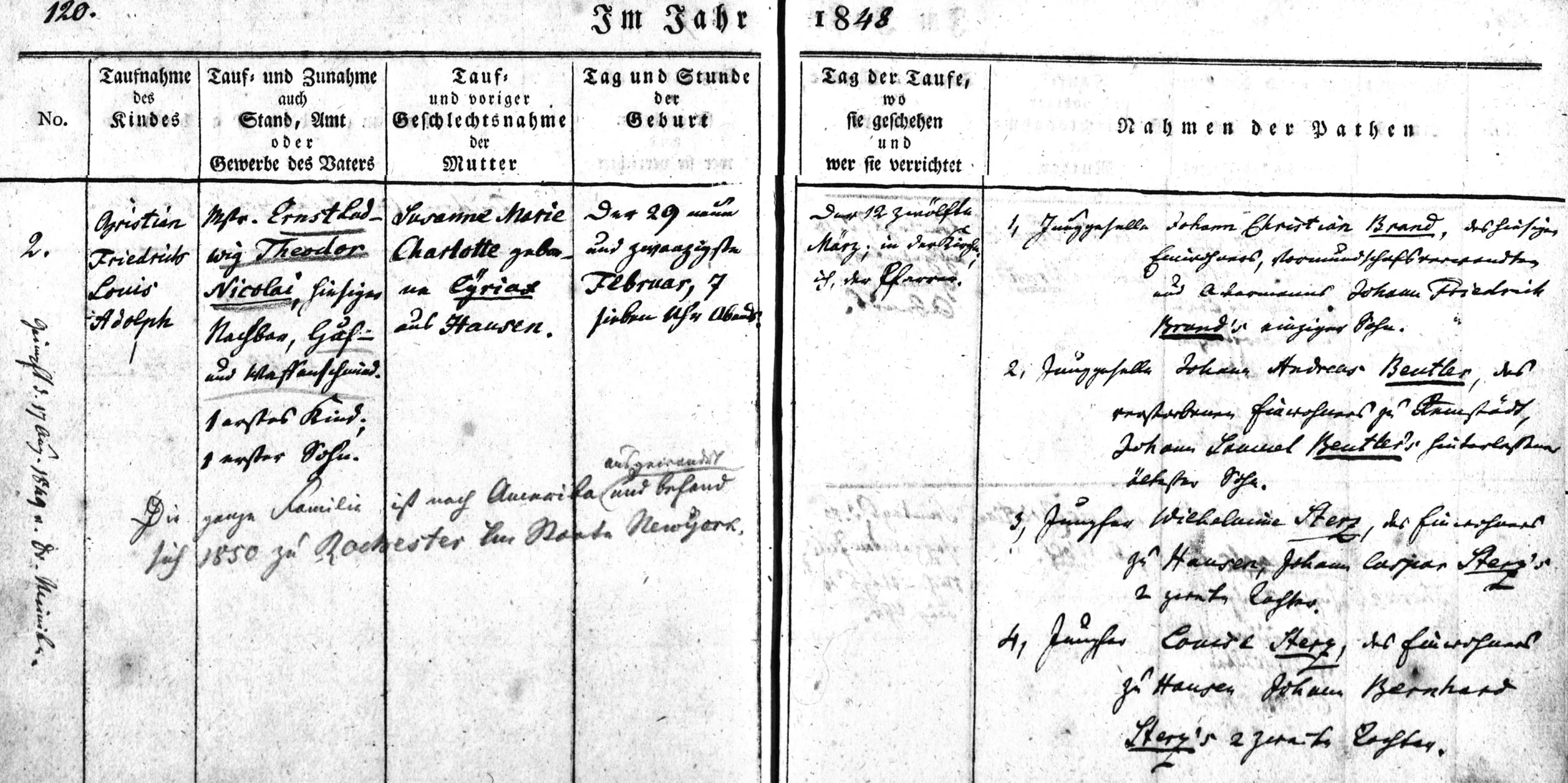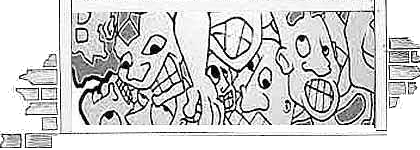Background
It has been a 50 year journey to undercover the ancestors of Charles Nicklos. It started in 1970 when Edith Nicklos wrote:
“Charles Nicklos’ father came from Saxe Coburg, Germany and settled in Rochester, New York. He married Elenora Brown. They had two children, Fredrick and Charles. Fredrick was seven years older than Charles. Their mother died when Charles was only a few years old, his father remarried, and when the war of States was on Fredrick enlisted as a drummer boy and was never heard from again. In the meantime, the father died and the step-mother remarried. Conditions were very bad during the war years so they moved to Canada.“
Then, in 1990, Gordon Nicklos hired a professional genealogist. He found that Ernst Nicolai, wife Charlotte, and two year old , Frederick, arrived in America arrived in New York on 8 June 1850 from Bremen Germany. The family came from Saxony (on census) or Saxe-Gortha (on naturalization papers). They settled in Rochester, New York where Charles, baptized as “Johann Christian”, was born on 5 Nov 1853 to Ernst and Charlotte (Zieryacks) Nicolaus. Charlotte died soon thereafter. Ernest remarried Eleanor Braun. In 1859, a daughter, Anna, was born. Frederick disappears after 1860, although the genealogist found an intriguing 1860 census entry for a Fredk C Nichols, age 12, residing at the House of Refuge.
My analysis in 2015 uncovered all the offspring for Ernest Nicholas. Unfortunately, this research produced no ancestors. That situation changed in 2020 with DNA matches that pointed to a possible sister of Ernest Nicholas, born Sophie Elisabethe Nicolai, based simply on the similarity of their last names and their connection to Saxony. A online marriage record identified their possible father as Johann Georg Nicolai.
2022 was a busy year. I potentially unraveled the mystery of Frederick Nicholas. More importantly, I tracked down the original marriage record for Sophie in 1839 which indicated Johann Georg Nicolai lived in Warza. Unfortunately, progress stopped because Warza church records had not yet been scanned. That wait ended with the recent release of the Gotha district church books by a German group called Archion. This collection includes the Warza church records.
The relevant articles related to this background can be found here:
- Ernest Nicholas (2017) – Discussion of the descendants of Ernest including all the children from his second wife.
- DNA of WAB, Pt 8: The Nicklos Subgroup (2020) – Bottom section of article “Ernest & Charlotte (Zieryacks) DNA” shows how Ernest Nicolaus and Sophie Nicolai share their DNA. Middle section “Nicklos DNA Analysis” discusses discovery of the bonus branch of the family.
- What Happened to Frederick Nicholas (2022) – 75% confidence that this story is accurate, but there is still room for some doubt. You get to decide.
- Johann Georg Nicolai (2022) – The discovery of the original marriage record for Sophie Nicolai which makes the connection to Warza
The Warza Records
Warza is a small rural village nearby to Gotha, located in the German state of Thuringia. The capital of Enfurt has an impressive medieval history. Thuringia largely escaped the ravages of World War II, then fell under the control of East Germany. As a result, progress of the cities stalled compared to its West German counterparts, and the region took on a gray cast associated with Communist industrialization. Church participation also fell as the government discouraged religion. With reunification, there has been a slow, steady effort to bring the standard of living in Thuringia to the same level as the rest of West Germany. I do not mean to paint too bleak of a picture. On a bus tour of Germany in 2012, I visited the beautiful Thuringian town of Weimar. Our local tour guide talked fondly of her East German experience as simple and peaceful time where all needs were provided by the government.
The Warza church records are surprisingly easy to read. The birth, marriage and death books all have an index. Duplicate books were also created, giving two samples of handwriting from each entry. As mentioned, Archion has only done the scanning which means you have to look through the books page by page. You also must translate the Kurrentscript (old German handwriting). Transcribing the church books will happen later. Let’s start with the most “recent” records and move back in time.
Birth of Frederick Nicholas in 1848
The birth record shows Frederick Nicholas as Christian Friedrich Louis Adolph Nicolai born in 1848 to Ernest Ludwig Theodor Nicolai and Susanna Marie Charlotte Cyriax. How do we know we got the correct record? It references the family’s move to Rochester. Notice the formal Christian names for all these individuals. More importantly, the identity of Charles’s mother has finally been uncovered. She is Charlotte Cyriax. A previous document had her last name “Zieryacks” which is actually a pretty close match considering the “C” and “Z” get swapped frequently in German.

Marriage of Ernst Nicolai and Charlotte Cyriax in 1846

The marriage of Ernst Nicolai, son of Johann Georg Nicolai, and Susanna Marie Charlotte Cyriax, daughter of Johann Christian Cyriax, took place in 1846. She came from Hausen. Here we see evidence that Ernst and Sophie Elisabethe both claim Johann George Nicolai as their father as predicted by the DNA. Also, we can also move one generation back with the name of Charlotte’s father, Johann Christian Cyriax. Although the Warza books make no more references to Cyriax, this record points us to the nearby town of Hausen for further research.
Birth of Charlotte Cyriax in 1823
Off to the Hausen church books for the birth of Susanna Maria Charlotte in 1823 to Johann Christian Cyriax and Maria Sophia Sterz. After a quick review of other records, we can also see the death of Johann Christian in 1843, while Susanna Maria died in 1823. Charlotte’s mother may have died in childbirth. Multiple references to the Cyriax and Sterz families show up in these Hausen church books. Best to leave further research to another time.

Birth of Ernst Nicolai in 1819

The birth of Ernest Nicolai occurred in Warza in 1819 to parents Johann Georg Nicholai and Sophie Rebecke Ellinger. Now we have a name for Ernest’s mother: Sophie Rebecke Ellinger. Johann Georg and Sophie Rebecke had several other children while in Warza starting with a daughter, Frederika Ernestine, in 1817. While she would later marry, several of her siblings died in infancy. The church records give additional insight. Sophie Rebecke died in 1838. Two years later, in 1840, Johann Georg remarried to Martha Wiegands. They had three additional children before he died in 1849.
No additional Nicolai references appear in Warza before 1817. No marriage for Ernest and Sophie, nor a birth of Sophie Elisabethe Nicolai emerge. This chronology suggests that the couple moved to Warza from another area of Germany around 1817. Here is where we get very lucky.
The Elxleben Records
Armed with this new information, I again searched the subset of German records that have been transcribed by Familysearch and Ancestry. Eureka. There is a marriage record of Johann Georg Nicolai born 1792 to Georg Nicolai and Sophie Rebecca Ellinger born 1791 to David Ellinger. The marriage took place in Elxleben, a small village near Erfurt. In addition, we can see the birth of three children while in Elxleben, including Sophie Elisabethe Nicolai. This last record represents the ultimate proof that Ernst and Sophie are bother/sister. The DNA evidence is correct.

Summary of these results
The updated tree summarizes all the new records that were discovered during this research. Usually you can connect your tree with others whose branches intersect. However, no connections have yet been found yet. The information in these church books is so new.
The villages of Warza, Hausen and Elxleben come across a being very small and rural. Georg, Johann and Ernst would provide an important service since they all shared the occupation of Blacksmith. German terms of Hufschmied (horse shoer) and Waffenschmeid (gunsmith) appear next to their names. These villages needed a local blacksmith to shoe their horses and to forge their farm tools. The job would have provided a solid middle class income and some stature in the village. Yet Ernst left with his young family to Rochester in 1850 soon after the death of his father in 1849. One can think of several reasons for the move, but his true motivation remains unclear. He remained a blacksmith in Rochester, then Canada. Charles Nicklos learned many of these skills which later allowed him to become a wizard at running the equipment of the oil rigs. It was in his DNA, so to speak (pun intended).
Pretty incredible how much we learned after our 50 year wait. These current records will reveal a more clues, since the Kurrentscript has not been been completely translated and more books need to be read. Stay tuned for a Part 2. Ultimately, transcription awaits these newly published church books. Genealogists will have years of “fun” connecting all these newfound families.
